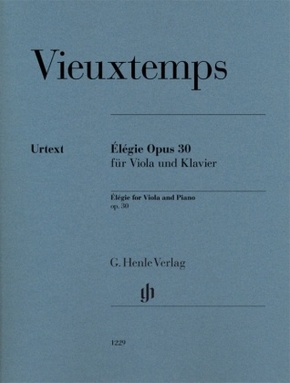
Henry Vieuxtemps - Élégie op. 30 für Viola und Klavier - Besetzung: Viola und Klavier
| Verlag | Henle |
| Auflage | 2014 |
| Seiten | 21 |
| Format | 23,5 x 31,0 x 0,3 cm |
| Gewicht | 120 g |
| Reihe | G. Henle Urtext-Ausgabe |
| ISBN-13 | 9790201812298 |
| Bestell-Nr | 48441006BA |
_mit bezeichneter und unbezeichneter Streicherstimme
Der unstete Lebensweg des Belgiers Vieuxtemps nahm wie kaum ein anderer im 19. Jahrhunderts den europäischen Gedanken vorweg. Bestes Beispiel ist die 1848 komponierte Élégie: Sie entstand in St. Petersburg, erlebte in Paris ihre größten Erfolge, wurde in Offenbach am Main gedruckt und in London enthusiastisch rezensiert. Besonders hervorgehoben wurden schon damals die ausdrucksvollen Kontraste sowie die Coda im Bravura-Stil, die "ebenso elegant wie brillant" sei. Nach der Sonate op. 36 (HN 577) erscheint mit der Élégie op. 30 ein weiteres Viola-Werk von Vieuxtemps erstmals in einer Urtextausgabe. Erneut konnte Tabea Zimmermann für die Strichbezeichnungen gewonnen werden, das Vorwort stammt von der Expertin Marie Cornaz.
Inhaltsverzeichnis:
Élégie op. 30
_with marked and unmarked string part
The peripatetic life and career of the Belgian composer Henry Vieuxtemps anticipated the European concept almost prophetically in the 19th century. The best example is his Élégie of 1848: written in St. Petersburg, it celebrated its greatest triumphs in Paris, was printed in Offenbach am Main, and enthusiastically reviewed in London. Critics were quick to note the expressive contrasts as well as the bravura style of the coda, which was "elegant and at the same time brilliant". Following the publication of the Sonata op. 36 (HN 577), the Élégie op. 30 now takes its place among Vieuxtemps' viola works for the first time in an Urtext edition. Tabea Zimmermann was once again entrusted with the bowings; the preface was written by the Vieuxtemps specialist Marie Cornaz.
